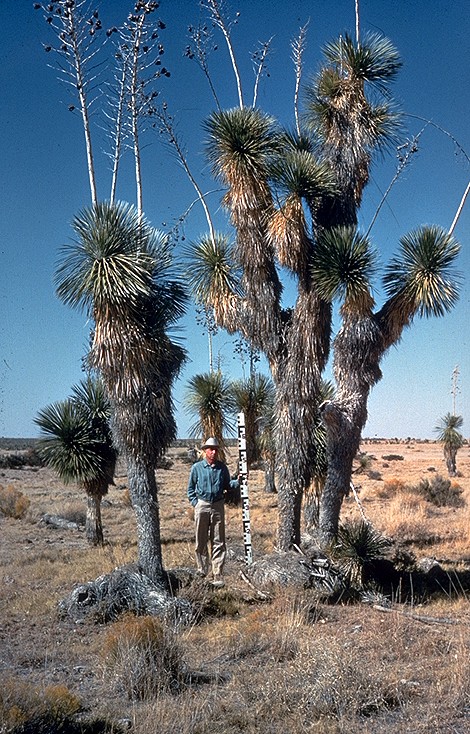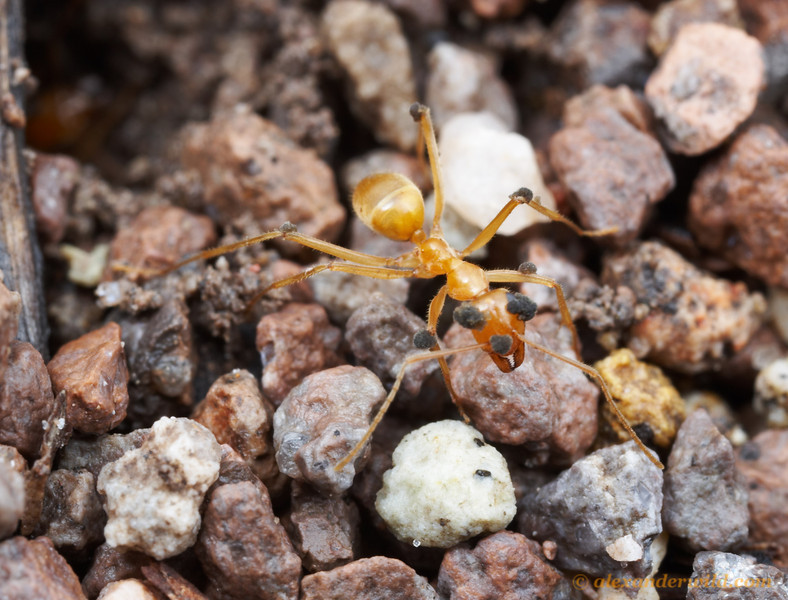Interactions With Other Species
A Honeypot Ant Being Consumed by a Fungus (not mentioned in text). Photo by Alex Wild.
Forelius
pruinosus, the dolichoderine ant, usually displaces the
Myrmecocystus mexicanus at food
baits. This shows interference competition between the species. This is
usually most intense where the ant colony densities are high and were food
supply is limited. These ants both compete for the fruits and flowers of the
Yucca elata
(Van Zee, 1997). The floral nectars
from this plant provide a rich source for these liquid feeding ants. The
fruit the yucca produces are often injured by the variety of animals, the
wounds of the fruit exude a liquid and gum-like material which is collected
by the ants. (Van Zee, 1997) Over lap of both species of ant was recorded
on the fruit, which is surprising because
M. mexicanus is nocturnal while
Conomyrma species are diurnal.
Myrmecocystus was absent on the
stalks of the yucca while many other species of ants, including the
dolichoderine ant was present. Because of the high numbers of dolichoderine
ants on the yucca, this results in low numbers of honeypot ants on the
yuccas. The dolichoderine ants secrete a chemical repellent of the honeypot
ants leading to the low numbers on the yuccas. The presents of dolichoderine
on the flowering stalk of the yucca either limits or eliminates the access
of M. mexicanus to the yucca
plants.
The Yucca
elata is a perennial plant that is native to the southwestern United
States. One average this plant grows from 1.2 to 4.5 meters tall (DesertUSA, 2013). It has a
sparsely branched truck that is usually brown and cylindrical. The yuccas
leaves are often arranged in a spiral whorl. Its fruit is a capsule which is
usually 5 to 8 centimeters long (DesertUSa, 2013). The yucca does not flower every year.
Yuccas do best in semi-arid conditions, they can handle cold temperatures
but require lots of sun light (DesertUSA, 2013).
2013). It has a
sparsely branched truck that is usually brown and cylindrical. The yuccas
leaves are often arranged in a spiral whorl. Its fruit is a capsule which is
usually 5 to 8 centimeters long (DesertUSa, 2013). The yucca does not flower every year.
Yuccas do best in semi-arid conditions, they can handle cold temperatures
but require lots of sun light (DesertUSA, 2013).
Dolichoderine ants are a subfamily of ants that are found in many places around the world. These ants are one of the most greatly divers ant species found throughout the world including places like Malaysia, the Middle East, and the Southwestern United States (AntWeb, 2013). Instead of relying on a sting, like many ants, The dolichoderine ants form a chemical compound which is used in defensive situations. These ants like the honeypot ants also feed on honey as part of their diet (AntWeb, 2013).
The honeypot ant,
M. mexicanus, interacts with both
of these species. it interacts with the
Yucca elata as a food source. It
gets both nectar from the flowers as well as different substances from the
fruit. M. mexicanus also
interacts with a species of dolichoderine ant. The relationship between
these species of ant is one of interference competition. Interference
Competition is when one species attempts to exclude another from a
particular food source (AntWeb, 2013). This competition effects
M. mexicanus in what resources it
can obtain from the Yucca elata.
The honeypot ant can often use the fallen fruit from the Yucca as a food
source but is very rarely seen on the Yucca plant itself (Van Zee et al.).
This is due to the Dolichoderine ants and the hormone that they secrete as a
repellant (Van Zee et al.).
Page Created By Kathryn Goodreau
